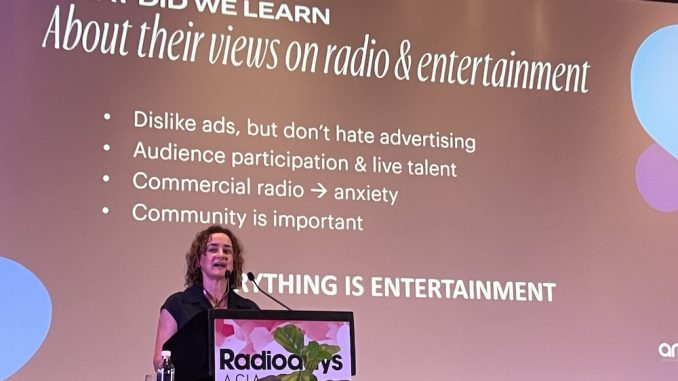
“CADA is a youth media brand not just a radio station,” Emily Copeland told RadioDays Asia, providing insights into how to attract youth audiences.
The station features “one of the most diverse lineups of talent” and has “extended the traditional commercial radio format” to multiple platforms to create a content ecosystem.
“Our audience keeps bouncing around in our ecosystem,” which has millions of connections each week, said Copeland. The station is now the number one station in breakfast and drive shifts in the DAB+ Sydney ratings. In six months the station had achieved 1 million podcast downloads of programs such as Flex and Frooms breakfast show and, in the first six months of this year has 20 million TikTok engagements and 77 million on Instagram.
“There were a lot of negative headlines around youth audiences and radio, there was discussion about young listeners turning away from radio. But I felt strongly that the problem was not that audiences were turning away, but they radio was not offering them what they wanted in the format they wanted it.”
The success of CADA is so far showing that young audiences will embrace radio if the right approach is adopted. Strategies and learnings from the station, which is about 18 months old, include:
- 18-29s spend a lot of time on their phones, looking for content and connections. These are two things that radio is excellent at providing if you get it right.
- The average young listener has a listening span of 8 seconds… our content “needs to move at the speed of youth culture… There are few mediums that can move at that speed, but radio can.”
CADA saw its opportunities for success in:
- Multiple platforms
- Representation of the target audience
- Mainstream – popular music and culture
“When we surveyed our potential audience they said they felt overlooked.” They did not find themselves represented in media and there was no content that interested them. According to Copeland, youth offerings felt vacuous, too focused on celebrity, or too opinionated and political.
So what did they want? Copeland asked them and this is what she found:
- They dislike ads but don’t hate advertising
- They value audience participation and live talent, which is something that music streamers like Spotify cannot offer
- They found traditional commercial radio content anxiety producing
- They believe that community is important and want to fell part of a community
“To them it doesn’t matter where the content sits… They trust certain content creators just as much as they trust the media platform or brand and station.”
With these insights Copeland developed a vision and strategy for CADA, which was originally a Sydney hip hop format.=
“We wanted CADA to stand for belonging, to reach audiences wherever they are consuming it. Talent, diversity and cultural credibility have come through faces and voices representing young Australia today.”
The station chose on air talent that didn’t necessarily have a background in radio, what they were looking for was that the talent connected with youth audiences. “We have a 3.6 million reach, we reflect what young Australia looks like today.”
The station has both a traditional radio studio and a video production studio, which allows it to turn around content at a fast pace.
Because the on air talent already have established public roles and other projects, they are not always able to commit to full days at the station, so Copeland has found ways to work smarter to get the most from the talent and devoted a lot of time to helping them learn the new radio environment.
We take a content multiplier approach, a one hour recording can make 3 hours of radio and be also be recut for social content.
Advertising is integrated into content whenever possible, using a partnerships driven content model. Relevance and community are the keys to attracting the young audience. “Reflect their interests and be where that are,” she said.
RadioDays Asia is taking place in Kuala Lumpur this week. More reports on radioinfo.asia.
